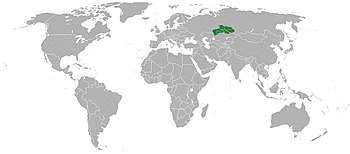Grey Ukraine
Grey Ukraine (also: Grey Klin - Siryi Klyn; Ukrainian: Сірий Клин, also: Сіра Україна - "Grey Ukraine"; Russian: Серый Клин) is an unofficial name for a region in Southern Siberia and Northern Kazakhstan, where there was mass settlement by Ukrainians at the end of the 19th and the beginning of the 20th century. 1917-1920 there was a movement for a Ukrainian autonomy in the region.
History

The Ukrainian settlement of Siryi Klyn (literally: the "grey wedge")[1] developed around the city of Omsk in western Siberia.[2] M. Bondarenko, an emigrant from Poltava province, wrote before World War I: "The city of Omsk looks like a typical Moscovite city, but the bazaar and markets speak Ukrainian". All around the city of Omsk stood Ukrainian villages. The settlement of people beyond the Ural mountains began in the 1860s. Altogether before 1914 1,604,873 emigrants from Ukraine settled the area.
Historical Grey Ukraine exists roughly within the present-day northern Kazakhstan and southern Siberia.[3][4][1] It is not contiguous with other territories inhabited by Ukrainian diaspora. A similar situation of territorial isolation exists with the Green Ukraine.[5]
Most of the Ukrainian migrations to Siberia happened during the late 19th century and early 20th century. However, the migrations continued throughout the Soviet period. Nikita Khrushchev's virgin lands campaign during the 1950s managed to encourage the migration.[2]
Demographics
According to the 2010 Russian census, 77,884 people (2.7%) of the Omsk Oblast identified themselves as Ukrainians, making Ukrainians the third-largest ethnic group there, after Russians and Kazakhs.[6]
See also
References
- Andrew Wilson (15 October 2015). The Ukrainians: Unexpected Nation, Fourth Edition. Yale University Press. p. 117. ISBN 978-0-300-21965-4.
- Andrew Wilson (1997). Ukrainian Nationalism in the 1990s: A Minority Faith. Cambridge University Press. p. 180. ISBN 978-0-521-57457-0.
- United States. Congress. House. Select Committee on Communist Aggression (1954). Baltic States investigation. U.S. Govt. Print. Off. p. 918.
- The Ukrainian Quarterly. Ukrainian Congress Committee of America. 1951. p. 56.
- Bohdan S. Wynar (2000). Independent Ukraine: A Bibliographic Guide to English-language Publications, 1989-1999. Ukrainian Academic Press. p. 101. ISBN 978-1-56308-670-0.
- Всероссийская перепись населения 2002 года: Приморский край [Russian Population Census 2002: Primorsky Krai] (in Russian). Demoscope.ru. 2002. Retrieved 3 June 2016.